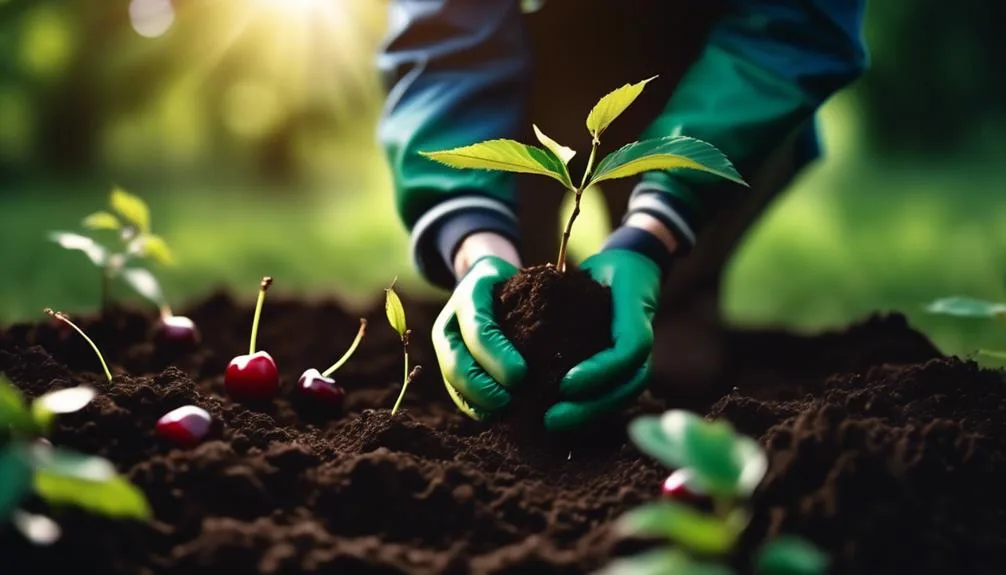Planting cherry trees successfully requires proper preparation and care.
Choosing the right location, preparing the soil, selecting the best variety, and planting the tree correctly are crucial steps for a healthy and fruitful tree.
Caring for the young tree during its initial growth phase is also important.
These practices lay the foundation for a plentiful harvest of delicious cherries.
Understanding the details of each step can significantly impact the tree's overall success.
Selecting the Right Location
Before planting your cherry tree, carefully examine your yard to find a location with well-draining soil and full sun exposure. Cherry trees thrive in sunlight, so choosing a spot with at least 6-8 hours of direct sunlight is essential for optimal growth and fruit production.
It's also crucial to ensure that the soil has good drainage to prevent waterlogging, which can lead to root rot. Test the soil pH to ensure it falls within the optimal range of 6.0-7.0 for cherry trees.
Additionally, consider the spacing between trees. If you're planting multiple cherry trees, they should be spaced about 20-25 feet apart to allow for proper air circulation and ample room for the roots to expand.
Taking these factors into account will set the stage for a successful cherry tree planting experience.
Preparing the Soil
To prepare the soil for planting your cherry tree, thoroughly loosen the top 12-18 inches of soil using a garden fork or tiller. This process helps the roots to penetrate easily and allows for better water and nutrient absorption.
Consider the soil composition; cherry trees thrive in well-draining soil with a pH level between 6.0 and 7.0. Adding organic matter such as compost or aged manure can improve the soil's structure and fertility.
Ensure the soil is evenly moist but not waterlogged before planting. Proper watering techniques are crucial for the tree's establishment. After planting, water the tree deeply and then monitor the moisture levels regularly, ensuring the soil remains consistently moist but not soggy.
With these soil preparation steps, your cherry tree will have an excellent foundation for healthy growth and abundant fruiting.
Choosing the Best Variety
When selecting a cherry tree variety, consider the climate and growing conditions in your area to ensure the best chance of success. Here are some key factors to consider when choosing the best variety:
- Variety Comparison: Research different cherry tree varieties to find one that suits your climate and soil type. Some popular sweet cherry varieties include Bing, Rainier, and Stella, while popular sour cherry varieties include Montmorency and Morello.
- Disease Resistance: Look for varieties that are resistant to common cherry tree diseases such as brown rot and powdery mildew. This can help reduce the need for chemical treatments and ensure a healthier tree.
- Pollination Requirements: Some cherry tree varieties require a different variety for cross-pollination. Be sure to check the pollination requirements of the variety you choose to ensure a good harvest.
Choosing the right cherry tree variety won't only affect the quantity of cherries you harvest but also the health and longevity of your tree.
Planting the Cherry Tree
Now that you've selected the best variety for your climate and soil type, it's time to move on to planting your cherry tree. When planting your cherry tree, it's crucial to ensure you dig the hole to the proper depth. Here's a guide to help you get it right:
| Step | Instructions |
|---|---|
| Digging the Hole | Dig a hole that is twice as wide as the root ball and just as deep. |
| Proper Depth | The depth of the hole should be such that the graft union is 2-3 inches above the soil level. |
Caring for the Young Tree
Once the cherry tree is planted, ensure you water it regularly and provide proper mulching to help retain moisture and suppress weed growth. As the tree grows, proper care is essential to ensure its health and productivity. Here are some tips for caring for your young cherry tree:
- Pruning techniques
Prune your cherry tree in late winter to early spring to remove dead or diseased branches, improve air circulation, and shape the tree for optimal growth.
- Watering schedule
Water your young cherry tree deeply once a week, especially during dry spells, to encourage deep root growth and prevent water stress.
- Pest control, mulching benefits
Apply organic mulch around the base of the tree to suppress weeds, conserve moisture, and regulate soil temperature. Additionally, regularly inspect the tree for pests and apply appropriate control measures if needed.
Conclusion
With these planting tips, you're well-equipped to nurture your cherry tree and savor the beauty and bounty it will bring.
Embrace the journey of tending to your tree, and witness the rewards it will offer in blossoms and fruit.
Happy planting!

My interest in trees started when I first saw the giant sequoias in Yosemite.
I was a teenager then, and I remember thinking, “I need to learn more about this.”
That moment stuck with me.
A few years later, I went on to study forestry at Michigan Tech.
Since graduating, I’ve worked in a mix of hands-on tree care and community education.
I’ve spent over ten years helping people understand how to plant, maintain, and protect the trees in their neighborhoods.
I don’t see trees as just part of the landscape.
They are living things that make a real difference in our daily lives.
